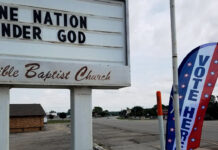In 1995, a movie called “White Man’s Burden” hit the theaters. It was a story about an alternate reality where the middle and upper class was comprised mainly of blacks, while whites were the poor minority. All the statistics involving crime was also reversed. The movie stared John Travolta and Harry Belafonte. Many people dismissed it at the time as a white apologist’s film.
Most of those people would be surprised to learn that this “alternate reality” actually did exist in our world. It was an area of Tulsa, Oklahoma in the early 20th century called “Little Africa,” also known by it’s more popular name: “Black Wall Street.”

Black Wall Street today remains one of the most remarkable minority communities ever created in the United States. This community had its own banks, bus system, one of the best school systems in the country, movie theaters, indoor plumbing (a very big deal in those days), low crime, and a very strong sense of community. If one black person was in trouble, the community rallied to their aid. If a house burned down, it was rebuilt within a week!
Blacks practiced what was called “nepotism.” This basically means that the people in the community looked after their own, opportunities were passed down to family first. Economically, money could circulate within that community 100 times or up to one year before it went to the outside world. Today money leaves most black communities in about 15 seconds. The result of this practice created many millionaires, by today’s standards. Black doctors, lawyers, business owners, artists all resided in Black Wall Street.
Black Wall Street was the Beverly Hills of Tulsa; it was in stark contrast to the poorer less-developed surrounding white communities, many of which did not have things like indoor plumbing. Resentment and envy grew year by year from the whites who lived on the other side of Tulsa. This resentment would soon turn into one of the darkest chapters of American History.
It all started with an accusation involving the rape of a white woman by a black man. What followed that slanderous lie was one of the bloodiest American horror stories in the nation’s history. An American horror story that was buried, and labeled a “race riot.” While a few World War I vets who lived in the community did try to defend their community, the Black Wall Street massacre was no more a race riot than was Rosewood, or any number of other black towns destroyed by evil men wearing white sheets.
It is unclear exactly how many people died as this community was burned to the ground. Some estimates say as few as 300 people died. While other estimates say that over 3,000 people died.
Conservatives often wonder why blacks in America call themselves African Americans or why they have such a cynical view of “The American Dream.” All the things they say blacks should do for themselves were once done! Had that community been allowed to thrive, who knows what impact it would have had blacks nationwide? The systematic destruction of the black community has never been more detailed and illustrated than in the American horror story that we call the black wall street massacre of 1921.
Here is a Young Turks video talking about the Black Wall Street Massacre.
Here is a more complete mini-documentary.




